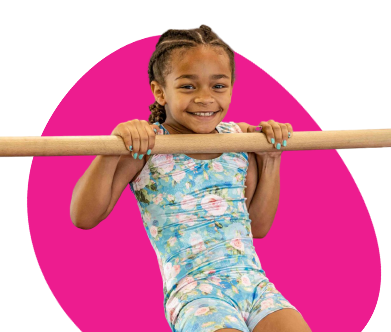
As parents, we’re always searching for the best activities to support our children’s development. What if we told you that those simple tumbles, rolls, and flips aren’t just fun—they’re actually building your child’s brain?
Tumbling skills play a crucial role in helping kids develop balance, spatial awareness, and coordination, all while allowing them to move and learn at their own pace. Through structured movement, basic skills lay the foundation for confidence and strength, making gymnastics classes an excellent way to support both cognitive and physical growth.
Why Tumbling Matters for Brain Development

When an infant first learns to roll over, they’re not just achieving a physical milestone—they’re building gross motor skills and developing balance through natural movement. These early floor exercises strengthen coordination and lay the foundation for more complex skills like crawling, standing, and eventually walking.
Encouraging these movements helps infants gain body awareness and control, setting them up for lifelong physical development.
Dr. Maria Johnson, child development specialist, explains: “Movement is the language of the developing brain. When children tumble, flip, and roll, they’re actually stimulating multiple brain regions simultaneously.”
Here’s what happens during tumbling activities:
1. Vestibular System Development: As your child strengthens their basic tumbling skills, their inner ear system develops, improving balance and spatial awareness—critical components for reading and math skills later .
2. Cross-Lateral Movement: Forward rolls and cartwheels require both sides of the brain to communicate, strengthening the corpus callosum—the bridge between left and right brain hemispheres.
3. Proprioception Enhancement: Tumbling helps children understand where their bodies are in space, a fundamental skill for everything from handwriting to athletic performance.
Age-Appropriate Tumbling Activities for Every Stage
For Babies (4-10 months)
Simple guided rolls on a soft mat develop core strength and sensory processing. Our Baby Birds classes introduce gentle tumbling movements that respect your infant’s developmental stage while encouraging exploration.
Toddler Tumbling Classes (10-36 months)
At this stage, tumbling skills like supervised forward rolls, animal walks, and balance exercises help toddlers develop coordination and confidence.
The Funny Bugs and Giggle Worms programs at The Little Gym create a fun and supportive space where kids can explore basic tumbling skills, improving strength, balance, and overall movement.
As they progress, they can continue building these foundational abilities in our Super Beasts classes, designed to further enhance agility, motor skills, and independence.
For Preschoolers (3-6 years)
More advanced tumbling sequences in our preschool gymnastics classes introduce children to momentum, body control, and sequencing, helping them focus on movement patterns while having fun! As your child participates in activities like jumping, agility drills , and more advanced skills, they develop coordination, strength, and confidence—all essential for growth in gymnastics.
Our Funny Bugs, Giggle Worms, and Good Friends classes provide a dynamic environment where kids explore new challenges at their skill level while refining tumbling techniques. Meanwhile, Flips/Hot Shots and Jazzy Bugs blend tumbling with rhythm and music, offering exciting opportunities for self-expression. Parents can watch their little ones build confidence and foundational movement skills in a tumbling class designed to inspire progress at every stage.
How Parents Can Support Tumbling Skills at Home

Between classes at The Little Gym, continue the developmental benefits with these safe at-home activities:
Between classes at The Little Gym, parents can help their little ones continue developing strength, flexibility, and coordination with fun, safe activities at home. These simple floor exercises provide a great basis for tumbling and allow kids to progress their skills in a playful way.
1. Somersault Practice
Encourage your child to practice somersaults and backward rolls on a soft surface, like an exercise mat or carpet. Guide them to tuck their chin, push off with their legs, and roll forward or backward smoothly. This helps build strength and improves body awareness for more advanced movements like twists and rolls.
2. Wall Handstands for Strength & Balance
For kids ready to progress their tumbling, a handstand against the wall is a great way to build strength, flexibility, and confidence. Start by having them place their hands on the floor and slowly walk their feet up the wall. This beginner-friendly drill strengthens the arms and core while reinforcing balance, an essential skill level for more advanced tumbling.
Practicing these moves at home helps reinforce what kids learn in class, keeping them engaged and excited about their gymnastics journey!
Beyond Physical Skills: The Emotional Benefits of Tumbling skills
Tumbling isn’t just about physical and cognitive development—it builds emotional resilience too. When children learn to fall safely and get back up, they develop perseverance and confidence that extends far beyond the gym mat.
Discover the Joy of Tumbling Through Kids’ Gymnastics classes

Tumbling and movement play a crucial role in early childhood development, helping children build spatial awareness, balance, and coordination from a young age. Through structured activities like gymnastics, kids develop confidence as they explore new skills at their own pace, strengthening both body and mind.
These movements not only support physical fitness and overall health but also encourage a lifelong love of fun and active learning. For families looking to introduce their child to the benefits of tumbling and movement, finding the right environment makes all the difference.
Find a location near you and discover how age-appropriate gymnastics classes can support your child’s growth and development.

